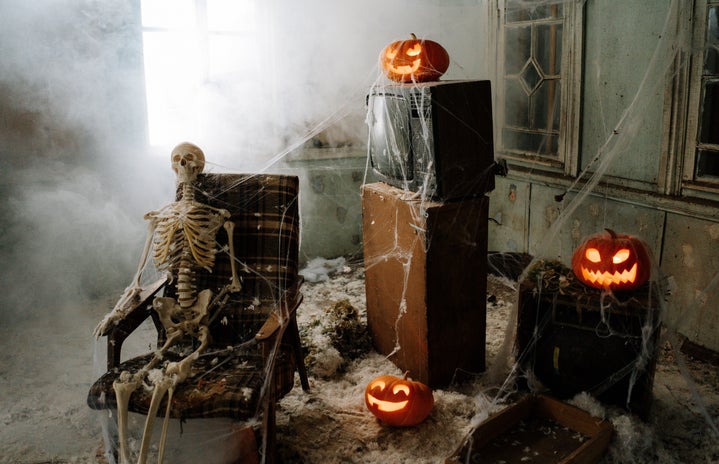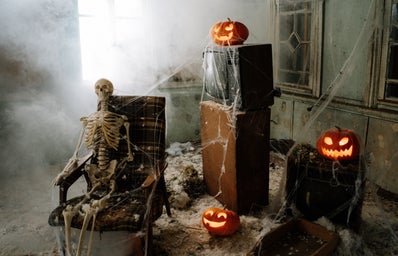What first comes to mind when you hear the word Halloween? Is it costumes and candy or vicious villains from blockbuster horror films? Filled to the brim with monsters and delectable treats, Halloween is a frightfully fun holiday that has been celebrated for decades.
We’ve all heard the spooky stories and legends of sleepy hollows, but what about the tale of Halloween itself? How did Oct. 31 become a long glowing night symbolized by black cats, witches and jack-o-lanterns?
Halloween’s origins date back thousands of years to the ancient traditions of the Celtic peoples who celebrated their new year on Nov. 1. The Celtic new year festival, Samhain (pronounced sow-in), was held on Oct. 31, marking the change of seasons. During this time, the summer and harvest season come to a close, and the frigid winter months approach. To celebrate the new year, the Celtic festival included feasts, preparations for winter, fortune telling and costumes, all luminated by the warm glow of large bonfires.
The Celts were polytheistic, meaning they worshipped various gods and goddesses. Their religion was closely connected to the natural world. They believed that on the night before the new year began, the wall between the living and the dead was the thinnest. It was believed that ghosts of the dead were able to roam the earth during this night. People longed for their departed loved ones and welcomed their spirits. With the blurred lines between one world and the next came unwelcome spirits, as well. To trick these spirits and deter unwanted attention, people would smear ashes from the festival’s bonfires on their face, which eventually lead to them wearing masks.
Stemming from this, people wore costumes (typically of animals) as disguises against ghosts. This way, the living could reveal themselves if they encountered a spirit of a loved one but could remain hidden from darker spirits. It was also said that during Samhain, food would be placed on people’s doorsteps as a gift to both the spirits of their loved ones, as well as a peace offering to troublesome ghosts. However, some people took a different approach by carving faces into vegetables, such as turnips and potatoes, to ward off these lingering spirits. This eventually led to the jack-o-lanterns we know and love today.
Taking advantage of the spiritual night, Celtic priests — also known as druids — often made predictions and told fortunes of the future. This was another activity done when ringing in the new year. From costumes to feasts, tales of the future and roaming spirits, Samhain can be largely credited to the haunting and spooky traditions of modern-day Halloween.
I’m sure you’ve heard of “All Hallows Eve,” but do you know it’s origins and how it later came to be known as Halloween? Despite the ghouls and goblins that represent this holiday, the word “hallow” actually means “holy” or to honor something that is holy.
The Roman Empire had conquered most of the Celtic land (what is now Ireland, northern France and the United Kingdom) by around 49 A.D., bringing the Christian faith with it. Over time, the celebration of Samhain was combined with similar Roman and Christian festivals that involved the dead.
Originally held on May 13, All Saints’ Day (also known as All Hallows’ Day) created by Pope Boniface IV in 609 A.D. was dedicated to honoring Christian saints and martyrs. Later moved to Nov. 1 by Pope Gregory III and altered to celebrate all saints, Oct. 31 became All Hallows’ Eve and, eventually, Halloween. It is widely believed (yet still debated) that Pope Gregory III’s decision to move All Saints’ Day to Nov. 1 was an attempt to rid of pagan beliefs and traditions such as Samhain.
So, how did this holiday with its association with religion become one of tricks-and-treats that we know today?
The tradition of trick-or-treating can be traced back to the night of All Hallow’s Eve. Poor people would go door-to-door of the rich and promise to pray for the homeowners’ dead relatives and their own souls in exchange for pastries to eat. Later on, the practice known as souling would be taken on by children, who would visit doorsteps asking for gifts, such as food and money. Over time, as the traditions made their way to the United States, people would give out candy in hopes to avoid pranks and other tricks done by children.
By the 1920s, Halloween parties and festivities had become a community-wide affair. People had taken the haunting yet celebratory undertones of Samhain and formed their own spooky holiday that centered around monsters, candy and costumes. Vandalism and pranking had become a part of the tradition, as Halloween had been transforming into a mischievous night, full of ghost stories and tricks, for years. This was taken under control by the 1950s, and since then, Halloween has become a holiday centered around children while appealing to lovers of spooks of all ages.
What was once a night that revolved around religion and spirits has transformed over the years into a frightful yet fun one for all. Whether you’re collecting candy, visiting haunted houses, creating a costume or playing tricks, you can now do so knowing how this haunting holiday came to be.


